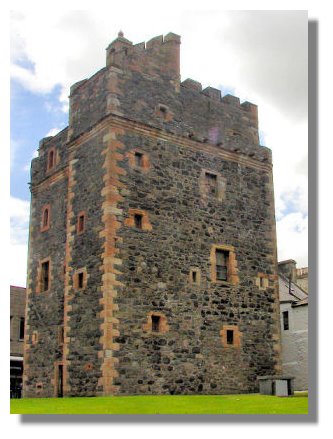
The Castle of St John was built around 1510 in what was later to become Stranraer - it is sometimes called Stranraer Castle. This small town overlooks Loch Ryan on the west of Dumfries and Galloway, although before the reorganisation of local government in Scotland, Stranraer was in Wigtownshire.
The land on which it was built was owned by a family called Adair. They were probably of Irish origin (Northern Ireland is only 40 miles away as the crow flies) and they held lands around Portpatrick to the west in the early 1300s. There is even a legend that they were allocated the area by King Robert the Bruce for getting rid of the previous occupants - the Curries - who were notorious pirates. Like all successful families in those days, they expanded their territory and acquired the lands on which the Castle of St John now stands by 1484. Initially, they built a chapel dedicated to St John and it was not until around 1510 that they built a castle which was known variously as the Place of St John and Castle of Chapel.
When the Burgh of Stranraer was created in 1595, its Charter specifically excluded the castle and grounds - but in favour of an Elizabeth Kennedy. Indeed, from 1600 onwards the Adairs concentrated on their lands in Ireland. The Castle of St John remained part of the Kennedy's estates until 1670 - at which point it was taken over by the Dalrymples of Stair. Sir James Dalrymple of Stair also obtained Castle Kennedy itself around the same time.
It continued in the role of prison until 1907. By that time it was surrounded by the shops and offices of a modern small town. In the 1960s, buildings surrounding the Castle of St John were demolished, leaving only the main tower - which was restored and became a museum and visitor attraction in 1988/89. The illustrations of Covenanters and their flags were taken inside the castle.
 Towards the end of the 17th century, the Castle of St John was used by the government to garrison troops who were trying to suppress the Covenanters, a religious movement that wanted to maintain the Presbyterian form of worship, where control was devolved to the individual church parishes. Although the government at that time was still in Edinburgh (the Union of the Parliaments of Scotland and England did not occur until 1707), King Charles I in London was trying to impose an episcopal system on both countries - with himself at its head and governing from the top down. Charles I lost his head in the Civil War and his son, King Charles II, was defeated at the Battle of Worcester in 1651 and had to flee. But King Charles II was restored in 1660 and soon resumed the efforts to impose an episcopal form of worship which the Covenanters resisted. In 1678, John Graham of Claverhouse (known as "Bonnie Dundee" or "Bloody Clavers" depending on which side you were on) was based at the Castle of St John while in command of troops in the south west, savagely suppressing the local Covenanters.
Towards the end of the 17th century, the Castle of St John was used by the government to garrison troops who were trying to suppress the Covenanters, a religious movement that wanted to maintain the Presbyterian form of worship, where control was devolved to the individual church parishes. Although the government at that time was still in Edinburgh (the Union of the Parliaments of Scotland and England did not occur until 1707), King Charles I in London was trying to impose an episcopal system on both countries - with himself at its head and governing from the top down. Charles I lost his head in the Civil War and his son, King Charles II, was defeated at the Battle of Worcester in 1651 and had to flee. But King Charles II was restored in 1660 and soon resumed the efforts to impose an episcopal form of worship which the Covenanters resisted. In 1678, John Graham of Claverhouse (known as "Bonnie Dundee" or "Bloody Clavers" depending on which side you were on) was based at the Castle of St John while in command of troops in the south west, savagely suppressing the local Covenanters.

In the 18th century the castle was little used and in 1815 it was purchased with a view to it becoming the jail for the area. In the following years it served that purpose - but gained a reputation for allowing too many prisoners to escape. Not that the building was insecure - but the jailers were often drunk and left the doors open!
 Castle Stalker
Castle Stalker


